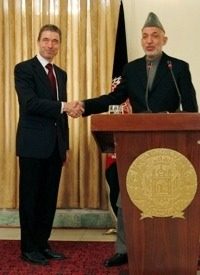
NATO Secretary-General Anders Fogh Rasmussen, upon completing a two-day visit to Afghanistan on December 22, pledged that the NATO-led International Security Assistance Force (ISAF) is committed to staying in the country until the Afghan government and military are ready to take over their own defense and that there would be no deadline for the exit of allied troops from the country.
Speaking at a joint news conference at the presidential palace in Kabul with President Hamid Karzai, Rasmussen signaled a change in strategy in 2010, when NATO will "focus much more" on protecting the population, roads, and development projects. Voice of America cited Rasmussen as stating that the addition of almost 40,000 additional troops will bring in a new phase of the NATO mission, which will be to bring more security to the Afghan people and which will turn over increasingly more responsibility to the Afghan government.
"My first message is to the Afghan people: I know that some are wondering how long international forces will stay, more specifically, they are worried we will leave too soon," Rasmussen told reporters.
"Let there be no doubt, the international community will stand with you, will protect you, and help rebuild your country until you are ready to stand on your own," he said.
Though Rasmussen said that Afghan police and soldiers would begin to take over security from foreign forces next year, he also stressed that the change would only come when the Afghans were ready. Reuters quoted Rasmussen saying: "They will start to take the lead when and where they are ready. This transition will be conditions based, not calendar driven. We will stay the course.”
An AFP report cited Rasmussen’s acknowledgement that the 113,000 NATO and U.S. troops in Afghanistan are paying as "heavy a price" as the people of Afghanistan. "But we know… that the price of leaving too early would be far higher so we will stay the course," he predicted.
The importance given to Rasmussen’s statement reveals an important aspect of our current military operation in Afghanistan: Though the bulk of the troops, materiel, and money are provided by the United States, this is a NATO operation. Though NATO was established for the stated purpose of defending post-war Western Europe against possible Soviet invasion, even that purpose has become obsolete. Moroever, Afghanistan is well outside the defense permimeter NATO suposedly was established to protect.
But there are even greater probems with NATO. Few people realize that the United Nations considers NATO to be a "regional arrangement" under UN Articles 51-54 of its charter.
As with the no-win UN-controlled military operation that the United States found itself entangled in in Korea, and the no win-war in Vietnam conducted under another UN “regional arrangement” — SEATO — our current military involvement in Afghanistan is but another quest to expand UN authority over the last remaining recalcitrant nations that resist being integrated into an emerging world government.
Once again, we find ourselves involved in a war not by a declaration of war by our Congress, as our Constitution stipulates, but under the auspices of a regional subsidiary of the UN, just as the original invasion of Afghanistan was "authorized" one day after 9/11, when President George W. Bush obtained UN authorization to attack Afghanistan.
Photo of Anders Fogh Rasmussen and Hamid Karzai: AP Images



